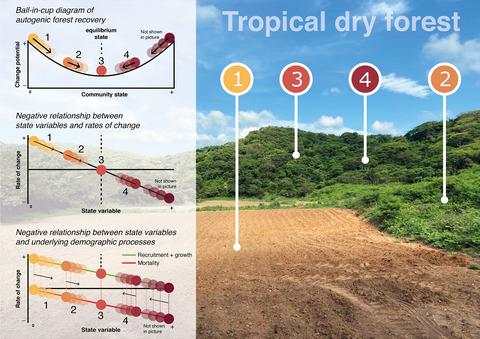Our official English website, www.x-mol.net, welcomes your feedback! (Note: you will need to create a separate account there.)
Autogenic regulation and resilience in tropical dry forest
Journal of Ecology ( IF 5.5 ) Pub Date : 2021-07-20 , DOI: 10.1111/1365-2745.13749 Rodrigo Muñoz 1, 2, 3 , Frans Bongers 2 , Danaë M. A. Rozendaal 2, 4, 5 , Edgar J. González 1 , Juan M. Dupuy 6 , Jorge A. Meave 1
中文翻译:

热带干旱森林的自生调节和恢复力
更新日期:2021-08-30
Journal of Ecology ( IF 5.5 ) Pub Date : 2021-07-20 , DOI: 10.1111/1365-2745.13749 Rodrigo Muñoz 1, 2, 3 , Frans Bongers 2 , Danaë M. A. Rozendaal 2, 4, 5 , Edgar J. González 1 , Juan M. Dupuy 6 , Jorge A. Meave 1
Affiliation

|
- Engineering resilience, a forest's ability to maintain its properties in the event of disturbance, comprises two components: resistance and recovery. In human-dominated landscapes, forest resilience depends mostly on recovery. Forest recovery largely depends on autogenic regulation, which entails a negative feedback loop between rates of change in forest state variables and state variables themselves. Hence community dynamics change in response to deviations from forest equilibrium state. Based on the premise that autogenic regulation is a key aspect of the recovery process, here we tested the hypothesis that combined old-growth forest (OGF) and secondary forest (SF) dynamics should show autogenic regulation in state variables, and thus convergence towards OGF-based reference points, indicating forest resilience.
- We integrated dynamic data for OGF (11-year monitoring) and SF (16-year monitoring) to analyse three key state variables (basal area, tree density and species richness), their annual rates of change and their underlying demographic processes (recruitment, growth and mortality). We examined autogenic regulation through generalized linear mixed-effects models (GLMMs) to quantify functional relationships between rates of change of state variables (and underlying demographic processes) and their respective state variables.
- State variables in OGF decreased moderately over time, against our prediction of OGF constancy. In turn, the three state variables analysed showed negative relationships with their respective rates of change, which allows the return of SF to OGF values after disturbance. In all cases, recruitment decreased with increasing values in state variables, while mortality increased.
- The observed negative relationships between state variables, their rates of change and their underlying demographic processes support our hypothesis of integrated OGF and SF dynamics showing autogenic regulation for state variables. Competition seems to be a major driver of autogenic regulation given its dependence on a resource availability that declines as forest structure develops.
- Synthesis. Based on a straightforward and comprehensive approach to quantify the extent to which tropical forest dynamics is self-regulated, this study highlights the importance of autogenic regulation for tropical dry forest as a basic component of its resilience. This approach is potentially valuable for a generalized assessment of engineering resilience of forests world-wide.
中文翻译:

热带干旱森林的自生调节和恢复力
- 工程复原力,即森林在受到干扰时保持其特性的能力,包括两个组成部分:抵抗力和恢复力。在人类主导的景观中,森林恢复力主要取决于恢复。森林恢复在很大程度上取决于自生调节,这需要森林状态变量的变化率和状态变量本身之间的负反馈循环。因此,群落动态会随着森林平衡状态的偏差而变化。基于自生调节是恢复过程的一个关键方面的前提,我们在这里测试了结合老林 (OGF) 和次生林 (SF) 动态应该在状态变量中显示自生调节的假设,从而向 OGF 收敛-基于参考点,表示森林恢复力。
- 我们整合了 OGF(11 年监测)和 SF(16 年监测)的动态数据,以分析三个关键状态变量(基面积、树木密度和物种丰富度)、它们的年变化率及其潜在的人口过程(招聘、生长和死亡率)。我们通过广义线性混合效应模型 (GLMM) 检查了自生调节,以量化状态变量(和潜在人口统计过程)变化率与其各自状态变量之间的函数关系。
- 与我们对 OGF 恒定性的预测相反,OGF 中的状态变量随着时间的推移适度减少。反过来,分析的三个状态变量与它们各自的变化率呈负相关,这使得 SF 在扰动后返回到 OGF 值。在所有情况下,招募随着状态变量值的增加而减少,而死亡率增加。
- 观察到的状态变量之间的负相关关系、它们的变化率及其潜在的人口统计过程支持我们的假设,即综合 OGF 和 SF 动态显示状态变量的自生调节。竞争似乎是自生调节的主要驱动力,因为它依赖于随着森林结构的发展而下降的资源可用性。
- 合成。基于量化热带森林动态自我调节程度的直接而全面的方法,本研究强调了热带干旱森林的自生调节作为其恢复力的基本组成部分的重要性。这种方法对于全球森林工程复原力的普遍评估具有潜在价值。



























 京公网安备 11010802027423号
京公网安备 11010802027423号